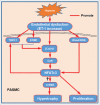The role of nuclear factor of activated T cells in pulmonary arterial hypertension
- PMID: 28103134
- PMCID: PMC5384583
- DOI: 10.1080/15384101.2017.1281485
The role of nuclear factor of activated T cells in pulmonary arterial hypertension
Abstract
Nuclear factor of activated T cells (NFAT) was first identified as a transcription factor about 3 decades ago and was not well studied until the development of immunosuppressant. Numerous studies confirm that calcineurin/NFAT signaling is very important in the development of vasculature and cardiovascular system during embryogenesis and is involved in the development of vascular diseases such as hypertension, atherosclerosis and restenosis. Recent studies demonstrated that NFAT proteins also regulate immune response and vascular cells in the pulmonary microenvironment. In this review, we will discuss how different NFAT isoforms contribute to pulmonary vascular remodeling and potential new therapeutic targets for treating pulmonary arterial hypertension.
Keywords: NFAT; calcineurin; hypoxia; proliferation; pulmonary arterial hypertension; vascular remodeling.
Figures


Similar articles
-
Calcineurin/NFAT Signaling Modulates Pulmonary Artery Smooth Muscle Cell Proliferation, Migration and Apoptosis in Monocrotaline-Induced Pulmonary Arterial Hypertension Rats.Cell Physiol Biochem. 2018;49(1):172-189. doi: 10.1159/000492852. Epub 2018 Aug 22. Cell Physiol Biochem. 2018. PMID: 30134231
-
Hydrogen ameliorates pulmonary hypertension in rats by anti-inflammatory and antioxidant effects.J Thorac Cardiovasc Surg. 2015 Sep;150(3):645-54.e3. doi: 10.1016/j.jtcvs.2015.05.052. Epub 2015 May 22. J Thorac Cardiovasc Surg. 2015. PMID: 26095621
-
Nuclear factor of activated T-cells transcription factors in the vasculature: the good guys or the bad guys?Curr Opin Lipidol. 2008 Oct;19(5):483-90. doi: 10.1097/MOL.0b013e32830dd545. Curr Opin Lipidol. 2008. PMID: 18769229 Review.
-
The vasoactive intestinal peptide gene is a key modulator of pulmonary vascular remodeling and inflammation.Ann N Y Acad Sci. 2008 Nov;1144:148-53. doi: 10.1196/annals.1418.014. Ann N Y Acad Sci. 2008. PMID: 19076374
-
Calcineurin-NFAT activation and DSCR-1 auto-inhibitory loop: how is homoeostasis regulated?J Biochem. 2014 Apr;155(4):217-26. doi: 10.1093/jb/mvu006. Epub 2014 Feb 5. J Biochem. 2014. PMID: 24505143 Review.
Cited by
-
AAV-mediated expression of NFAT decoy oligonucleotides protects from cardiac hypertrophy and heart failure.Basic Res Cardiol. 2021 Jun 4;116(1):38. doi: 10.1007/s00395-021-00880-w. Basic Res Cardiol. 2021. PMID: 34089101 Free PMC article.
-
Omega-3 polyunsaturated fatty acids and pulmonary arterial hypertension: Insights and perspectives.Eur J Clin Invest. 2024 Nov;54(11):e14277. doi: 10.1111/eci.14277. Epub 2024 Jun 28. Eur J Clin Invest. 2024. PMID: 38940236 Review.
-
Mitochondrial Dysfunction in Pulmonary Hypertension.Antioxidants (Basel). 2023 Feb 3;12(2):372. doi: 10.3390/antiox12020372. Antioxidants (Basel). 2023. PMID: 36829931 Free PMC article. Review.
-
PDGF mediates pulmonary arterial smooth muscle cell proliferation and migration by regulating NFATc2.Mol Med Rep. 2021 Jan;23(1):39. doi: 10.3892/mmr.2020.11677. Epub 2020 Nov 12. Mol Med Rep. 2021. PMID: 33179105 Free PMC article.
-
Critical effects of epigenetic regulation in pulmonary arterial hypertension.Cell Mol Life Sci. 2017 Oct;74(20):3789-3808. doi: 10.1007/s00018-017-2551-8. Epub 2017 Jun 1. Cell Mol Life Sci. 2017. PMID: 28573430 Free PMC article. Review.
References
-
- Shou J, Jing J, Xie J, You L, Jing Z, Yao J, Han W, Pan H. Nuclear factor of activated T cells in cancer development and treatment. Cancer Lett 2015; 361(2):174-184; PMID:25766658; http://dx.doi.org/ 10.1016/j.canlet.2015.03.005 - DOI - PubMed
-
- Simonneau G, Galiè N, Rubin LJ, Langleben D, Seeger W, Domenighetti G, Gibbs S, Lebrec D, Speich R, Beghetti M, et al.. Clinical classification of pulmonary hypertension. J Am Coll Cardiol 2004; 43(12 Suppl S):5S-12S; http://dx.doi.org/ 10.1016/j.jacc.2004.02.037 - DOI - PubMed
-
- Stenmark KR, Tuder RM, El Kasmi KC. Metabolic reprogramming and inflammation act in concert to control vascular remodeling in hypoxicpulmonary hypertension. J Appl Physiol (1985) 2015; 119(10):1164-1172; PMID:25930027; http://dx.doi.org/ 10.1152/japplphysiol.00283.2015 - DOI - PMC - PubMed
-
- El Chami H, Hassoun PM. Immune and inflammatory mechanisms in pulmonary arterial hypertension. Prog Cardiovasc Dis 2012; 55(2):218-228; http://dx.doi.org/ 10.1016/j.pcad.2012.07.006 - DOI - PMC - PubMed
-
- Hassoun PM, Mouthon L, Barberà JA, Eddahibi S, Flores SC, Grimminger F, Jones PL, Maitland ML, Michelakis ED, Morrell NW, et al.. Inflammation, growth factors, and pulmonary vascular remodeling. J Am Coll Cardiol 2009; 54(1 Suppl):S10-S19; http://dx.doi.org/ 10.1016/j.jacc.2009.04.006 - DOI - PubMed
Publication types
MeSH terms
Substances
LinkOut - more resources
Full Text Sources
Other Literature Sources
Medical
